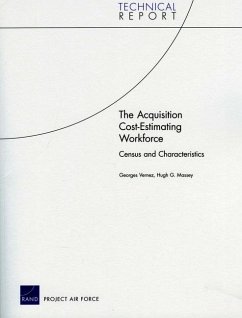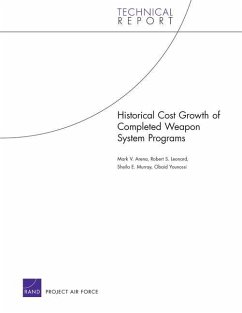
The Impact of Economic Factors and Acquisition Reforms on the Cost of Defense Weapon Systems
Versandkostenfrei!
Versandfertig in über 4 Wochen
15,99 €
inkl. MwSt.

PAYBACK Punkte
8 °P sammeln!
Cost overruns in weapon system purchases have plagued the Department of Defense (DoD) throughout its history and have resulted in schedule delays and potentially reduced combat capability. This thesis created an empirical model that begins to explain those cost overruns. The model describes how changes in defense budgets, consolidation of the defense industry, acquisition reform, war, and cost estimating error are related to cost overruns. The cost performance of 186 major weapon system programs managed by the Air Force, Army, and Navy from 1970 to 2002 was described using a panel regression m...
Cost overruns in weapon system purchases have plagued the Department of Defense (DoD) throughout its history and have resulted in schedule delays and potentially reduced combat capability. This thesis created an empirical model that begins to explain those cost overruns. The model describes how changes in defense budgets, consolidation of the defense industry, acquisition reform, war, and cost estimating error are related to cost overruns. The cost performance of 186 major weapon system programs managed by the Air Force, Army, and Navy from 1970 to 2002 was described using a panel regression model. This research found that funding instability resulting from changing levels of defense budgets accounted for an increase of over $13.3 billion in weapon system costs since 1970. This research also found that the defense industry consolidation of the 1990's did not result in significant savings to the DoD. Finally, this research found that contrary to past studies, several acquisition reforms are correlated with a decrease in weapon system cost overruns. In particular, reforms resulting from the Nunn-McCurdy Act of 1982, the Packard Commission Recommendations of 1986 and the Federal Acquisition Streamlining Act (FASA) of 1994 resulted in savings of almost $124 billion since 1982. This work has been selected by scholars as being culturally important, and is part of the knowledge base of civilization as we know it. This work was reproduced from the original artifact, and remains as true to the original work as possible. Therefore, you will see the original copyright references, library stamps (as most of these works have been housed in our most important libraries around the world), and other notations in the work. This work is in the public domain in the United States of America, and possibly other nations. Within the United States, you may freely copy and distribute this work, as no entity (individual or corporate) has a copyright on the body of the work. As a reproduction of a historical artifact, this work may contain missing or blurred pages, poor pictures, errant marks, etc. Scholars believe, and we concur, that this work is important enough to be preserved, reproduced, and made generally available to the public. We appreciate your support of the preservation process, and thank you for being an important part of keeping this knowledge alive and relevant.












